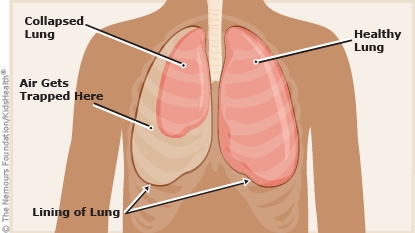A collapsed lung (also called a pneumothorax) is when a collection of air leaks out of the lung and gets trapped in the space around it. This causes part of the lung to deflate like a balloon. A chest tube is a small tube placed into the space around the lung to release the trapped air so the lung can reinflate.
Most kids recover well from a collapsed lung, but it's important to watch for returning symptoms.



Your child has:

Your child:
Call 911 if chest pain and shortness of breath start suddenly or if your child passes out.

What can cause a collapsed lung? A collapsed lung can be spontaneous or traumatic:
Can a collapsed lung happen again? Kids who have had a spontaneous collapsed lung could get another one. Make sure you and your child know the signs of a collapsed lung (like chest pain and trouble breathing) and get help right away if they happen.